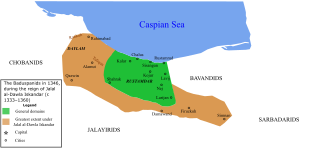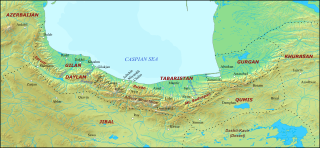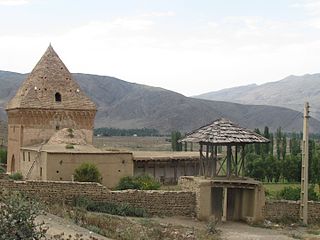Related Research Articles

The Marashiyan or Marashis were an Iranian Sayyid Twelver Shiʿite dynasty of Mazandarani origin, ruling in Mazandaran from 1359 to 1596. The dynasty was founded by Mir-i Buzurg, a Sayyid native to Dabudasht. Their capitals were Amol, Sari, and Vatashan.

The Baduspanids or Badusbanids, were a local Iranian dynasty of Tabaristan which ruled over Ruyan/Rustamdar. The dynasty was established in 665, and with 933 years of rule as the longest dynasty in Iran, it ended in 1598 when the Safavids invaded and conquered their domains.
Hasan II, also known as Fakhr al-Dawla Hasan, was the last ruler of the Bavand dynasty from 1334 until his murder in 1349. He was the brother and successor of Sharaf al-Muluk.
Jalal al-Dawla Iskandar was the ruler (ustandar) of the Baduspanids from 1333 to 1360. Under his rule, the kingdom reached its zenith. Taking advantage of the collapse of the Mongol Ilkhanate in 1335, he expanded his rule into the southern Alborz, ruling an area stretching from Qazvin to Simnan. In 1346, he founded the town of Kojur and conquered the region of Daylam. In 1360, he was mortally wounded by his bodyguard during a ruckus at a drinking party. He died three days later, and was succeeded by his brother Fakhr al-Dawla Shah-Ghazi.
Iskandar-i Shaykhi, was an Iranian ispahbad from the Afrasiyab dynasty, who ruled Amul as a Timurid vassal from 1393 to 1403. He was the youngest son of Kiya Afrasiyab, who had initially established his rule in eastern Mazandaran from 1349 to 1359, but was defeated and killed by the local shaykh Mir-i Buzurg, who established his own dynasty—the Mar'ashis—in the region. Together with some supporters and two nephews of his father, Iskandar initially took refuge in Larijan, but later left for Herat, where entered into the service of the Kartid ruler Ghiyath al-Din II.
Al-Marzuban or Marzuban bin Rustam of Parim, was the thirteenth ruler of the Bavand dynasty from 979 to 986. He was the son and successor of Rustam II. In some sources, his name was changed to Rustam ibn al-Marzuban, which caused confusion among the historians, and made them think that they were two people.
Kai Ka'us I, was the ruler of the Paduspanid dynasty from 1168 to 1184. He was the brother and successor of Shahrivash.
Ardashir I, was the ruler of the Bavand dynasty from 1173 to 1205. He was the son and successor of Hasan I.
Zahir al-Din Mar'ashi Amoli was a Persian commander, diplomat and historian. He is the author of several books on the history of Tabarestan. He was born in 812 AH and died after 894 AH. He was from Mar'ashi family, an originally seyyed family in Tabarestan who dominated the region from the later 8th/14th century until the province's incorporation into Safavid Empire by Abbas I of Persia in 1005/1596. He stemmed from the main branch of Mar'ashis, that of Kamal al-Din ibn Kiwan al-Din. He owned states at Bazargah at Gilan and was employed by Sultan Muhammad II of Kar Kia line in Gilan and then by his son an successor Mirza Ali. He was sent to resolve militarily a succession dispute in adjacent Rustamdar and he led other expeditions, including an unsuccessful siege of Nur in 868/1463.

Ruyan, later known as Rustamdar (رستمدار), was the name of a mountainous district that encompassed the western part of Tabaristan/Mazandaran, a region on the Caspian coast of northern Iran.

Kayumarth I was the ruler (ustandar) of the Baduspanids from 1394 to 1453, with a three-year interruption. An active expansionist ruler, his kingdom experienced a resurgence during his long reign, which included the reconquest of Rustamdar. He was often at odds with his suzerain, the Timurid ruler Shah Rukh. After his death, a dynastic struggle followed, which resulted in his kingdom being split up by his sons Iskandar IV and Ka'us II, in Kojur and Nur respectively.
Sayyid Ali Sari was the Mar'ashi ruler of Amul and Sari from 1406 to 1417. He was a son of Kamal al-Din I, and was succeeded by his son Sayyid Murtada.
Fakhr al-Dawla Shah-Ghazi was the Baduspanid ruler (ustandar) of Rustamdar from 1360 to 1379. He is notable for sponsoring the composition of the history chronicle Tarikh-i Ruyan by Awliya Allah Amuli. He died in 1379 and was succeeded by his son Adud al-Dawla Qubad.
Sayyid Fakhr al-Din was a Mar'ashi prince, who ruled the region of Rustamdar from 1381 to 1390. He shared power with his three other brothers; Kamal al-Din I in Sari; Rida al-Din in Amul; and Sharaf al-Din in Karatughan. Together, they ruled a realm encompassing all of Mazandaran, reaching as far west to the city of Qazvin. They had inherited this realm from their father Mir-i Buzurg, the founder of the Mar'ashis.
Sa'd al-Dawla Tus was the Baduspanid ruler (ustandar) of Rustamdar from 1390 to 1394. He was a son of ustandar Taj al-Dawla Ziyar.
Taj al-Dawla Ziyar was the Baduspanid ruler (ustandar) of Rustamdar from 1325 to 1333. He succeeded to the throne after instigating the murder of his predecessor and brother Nasir al-Din Shahriyar through his son Iskandar.
Nasir al-Din Shahriyar was the Baduspanid ruler (ustandar) of Rustamdar from 1317 to 1325. He was the brother and successor of Shams al-Muluk Muhammad.
Shams al-Muluk Muhammad was the Baduspanid ruler (ustandar) of Rustamdar from 1312/3 to 1317. He was the son and successor of Kay Khusraw.
Kay Khusraw was the Baduspanid ruler (ustandar) of Rustamdar from 1301/2 to 1312/3. He was the brother and successor of Namawar Shah Ghazi.
Namawar Shah Ghazi was the Baduspanid ruler (ustandar) of Rustamdar from 1272/3 to 1301/2. He was the son and successor of Shahragim.
References
- 1 2 3 Madelung 1988, pp. 385–391.
- ↑ Calmard 1991, pp. 511–512.